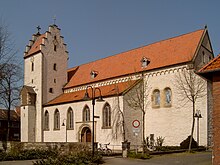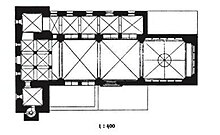Metelen Monastery
The monastery later metelen monastery in the municipality of Metelen ( Steinfurt district ; North Rhine-Westphalia ) was founded in 889. At first it was a nunnery directly connected to the empire , from the 13th century it was a canon monastery and some of the residents lived according to the Augustinian rule . At the end of the 15th century it was converted into a free worldly women's monastery . It was secularized in 1803 and 1810 respectively .
Foundation phase

For the location of the monastery, an important military route and the proximity of various castle complexes played a role. A noble lady Friduwi founded a monastery in 889 and made her property available as an economic basis. The founder came from the Billunger family . It belonged to the earliest group of women's monasteries in Westphalia. It was consecrated to Saints Cornelius and Cyprianus.
King Arnulf of Carinthia gave permission for this . This also granted him full immunity , assured the free choice of the abbess and placed the monastery under royal protection. For this purpose, a guardian was appointed. In contrast to the neighboring farmers, the monastery and the settlement around it were imperial . It was the only monastery in the diocese of Münster with this status.
Development in the Middle Ages
When the family of the monastery founder died out around the year 992, a conflict arose with the Bishop of Münster, who wanted to bring the monastery under his control over the right to elect a bailiff . Otto III. decided in favor of the nuns. The abbess was confirmed in the traditional rights and Wichmann III. used as Vogt.
Later, however, the bishops of Munster succeeded in gaining the right to confirm the election of abbesses and the rights to occupy the bailiwick.
The bailiwick was initially due to the Lords of Metelen from the Billunger family. Since 1173 the counts of Tecklenburg were bailiffs. Abbess Oda (1310-1352) began to solve the monastery from this dependency. Since 1319 she bought Vogteirechte from the Counts of Tecklenburg through a number of monastery yards. In 1337 she also bought the court rights and the market police in the area of Wigbold Metelen. For the wigbold, judges of the abbey were appointed. Attempts by the bishops of Munster to obtain these rights failed. The court of appeal in Metelen was the council of the city of Coesfeld . The abbess has since played a leading role in Metelen.
Until 1040 the monastery and the peasants belonging to it belonged to the parish Wettringen . After that it became its own parish. In 1193 the abbess was enfeoffed with the archdeaconate Metelen.
Convention
The convent consisted of 13-15 women. In the Middle Ages these came from aristocratic, but sometimes also from middle-class families. Later they came almost exclusively from families of the nobility.
The abbesses belonged to the count's families in the area, at least until the Reformation. Sometimes the abbess was also the head of other spiritual institutions. However, only three abbesses are known by name between the 9th and 13th centuries. Another three are known from the 13th century. Of these, two were also abbesses in Nottuln .
Five male clergymen (canons) were added to the abbess and nuns or canons.
Possessions
Around 1350 the monastery had around 100 farms that were subject to tax. These were located in 40 villages in the Münsterland as far as Holland. The place one, for example, was a foundation of the monastery and was originally a good and benefice. This number increased and in 1539 there were 145 farms. The income was regulated in 1417. The earnings of some courts belonged to the abbess, others to the convent, and still others to both sides.
Time as a lady's pen
The conversion to a pen at the end of the 15th century led to some changes. Common facilities such as the refectory and dormitory no longer played a role. The existing common assets of the Convention was in prebends divided. The canons now lived in their own buildings (“curia”) that were connected to the cloister . The buildings were owned by the respective noble families. Instead of religious clothing, women were allowed to wear secular clothing from 1532. However, there was still a residence requirement.
Against the attempt by the Bishop of Münster to gain the power of the keys over the city gates of Metelen, the monastery and the city that has now emerged jointly prevailed. In the early modern period, the commune recognized the abbess as the city's mistress. In the article letter of 1591 the rights of the city and the monastery were established.
A departure from Catholicism threatened in the 16th century. A visitation in 1572 showed that Evangelical beliefs prevailed in Metelen. These tendencies were subsequently suppressed. At the visit of 1616 no more Reformation influences were noticeable.
During the Thirty Years' War, the monastery suffered from the events of the war. In 1623 Christian von Braunschweig occupied the monastery before the battle in the Lohner Bruch .
In 1720 the abbess Cornelia Anna Droste zu Vischering began building new monastery buildings. The abbess's house dates from this period. The monastery house of Maria Clara von Oer zu Egelborg from the same period has been preserved .
One of the last abbesses was Anna Elisabeth von Droste zu Hülshoff (1733–1805), whose godchild and great niece, the poet Annette von Droste-Hülshoff , visited her in Metelen with her family.
secularization
After the Reichsdeputationshauptschluss the monastery was abolished and the possessions fell to the Wild and Rhine Count of Salm-Grumbach . The canonesses did not recognize this and in 1805 appealed to the Reich Chamber of Commerce . Since 1806 the monastery belonged to the Napoleonic Grand Duchy of Berg . Joachim Murat regarded the repeal as not having taken place and appointed a niece as abbess. It was not finally secularized until 1810. The former canons received pensions.
Even after the end of Napoleonic rule, the canons held on to their claims against the Rheingrafen zu Salm. The legal disputes dragged on into the 1820s before the Salm family was able to prevail.
Some buildings were sold, others demolished. The houses of the canons were also sold by the families who owned them.
Buildings
Metelen Abbey was closed off from the outside by walls, gates and buildings. A gate allowed entry into the inner area of the pen. In addition to the collegiate church of St. Cornelius and Cyprian , there was a cloister with an inner courtyard, around which the actual buildings of the convent and the abbess's house were grouped.
Towards the end of the 12th century the west building of the church was built. In the second quarter of the 13th century the building of the hall longhouse of the church followed. The western entrance hall was reduced by a yoke. The church is a two-aisled hall without a transept. In 1720 a new abbey building and monastery house were built. In 1798 the neighboring church of St. Vitus, built around 1100, was demolished. In the middle of the 19th century the church was rebuilt and a new sacristy was built. In the 1930s the ground was deepened and archaeological excavations were made. In the years between 1957 and 1961 restoration work and structural investigations were carried out.
literature
- Irene Crusius (Hrsg.): Studies on the canon pin. Vandenhoeck and Ruprecht, Göttingen 2001, ISBN 3-525-35326-X ( Studies on Germania Sacra 24, publications by the Max Planck Institute for History 167) Partial digitization .
- Karl Döhmann: Historical introduction . In: Albert Ludorff : Architectural and art monuments of the Steinfurt district. Schöningh, Münster 1904, pp. 73-75 ( The architectural and art monuments of Westphalia 15).
- Wilhelm Kohl : The dioceses of the church province Cologne. The diocese of Münster. Volume 7, 1: The Diocese . de Gruyter, Berlin et al. 1999 ( Germania Sacra NF 37, 1), partially digitized .
- Wilhelm Kohl: The dioceses of the church province Cologne. The diocese of Münster. Volume 7, 3: The Diocese . de Gruyter, Berlin et al. 2003 ( Germania Sacra NF 37, 3), partially digitized .
- Wilhelm Kohl: women's monastery in Westphalia . In: Géza Jászai (Ed.): Monastic Westphalia. Monasteries and monasteries 800–1800. Westfälisches Landesmuseum für Kunst und Kulturgeschichte, Münster 1982, ISBN 3-88789-054-X , pp. 33–38 (exhibition catalog, Münster, Westfälisches Landesmuseum für Kunst und Kulturgeschichte, September 26, 1982 - November 21, 1982).
- Heiko KL Schulze: Monasteries and monasteries in Westphalia. History, building history and description. A documentation . In: Géza Jászai (Ed.): Monastic Westphalia. Monasteries and monasteries 800–1800. Westfälisches Landesmuseum für Kunst und Kulturgeschichte, Münster 1982, ISBN 3-88789-054-X , pp. 385–386 (exhibition catalog, Münster, Westfälisches Landesmuseum für Kunst und Kulturgeschichte, September 26, 1982 - November 21, 1982).
- Reinhard Brahm: Ladies Monastery Metelen: information, monastery guide. Metelen, 2009 Access to digitized material
Web links
- Metelen community history
- Metelen Catholic Church History
- Stiftsführer (PDF file; 880 kB)
- Landschaftsverband Westfalen-Lippe: Abbey garden Metelen in LWL geodata culture
Individual evidence
- ↑ Kohl, Westphalian women's monastery, p. 33.
- ↑ a b Germania Sacra NF 37.3, p. 68.
- ↑ Kohl, Westphalian women's monastery, p. 36.
- ↑ a b Germania Sacra NF 37.1, p. 489.
- ↑ Germania Sacra NF 37.3, p. 42.
- ↑ Germania Sacra NF 37.1, p. 67.
- ↑ a b Crusius, Kanonissen, p. 62.
- ↑ Crusius, Kanonissen, p. 351.
Coordinates: 52 ° 8 ′ 41.8 ″ N , 7 ° 12 ′ 45.9 ″ E



